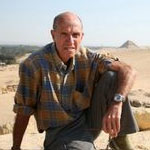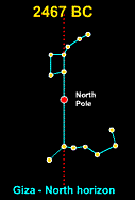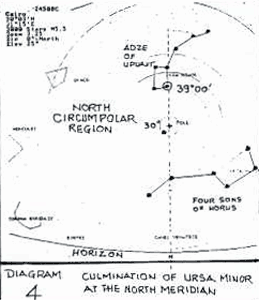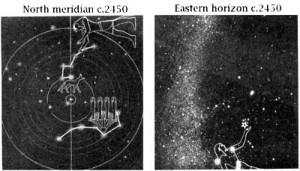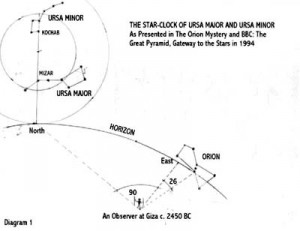Dozens of newspapers and websites announced yesterday (16 November 2000) a major ‘breakthrough discovery’ by Kate Spence, a PhD researcher at Cambridge University that was published in the journal Nature. The main ‘breakthrough’ hailed by the media concerns the accurate dating of the Great Pyramid by modelling the precession of the transit of two stars, Kochab (in Ursa Minor) and Mizar (in Ursa Major), at the north meridian of the sky. According to Kate Spence,
“The ancient Egyptian Pyramids of Giza have never been accurately dated… Modelling the precession of these stars yields a date to the start of construction of the Great Pyramid that is accurate to ±5yr, thereby providing an anchor for the Old Kingdom chronologies” .
In addition Kate makes two further claims: (a) that the simultaneous transit of these two stars was used by all the Pyramid Builders of the Old Kingdom from the 4th Dynasty onwards to anchor their pyramids to true north, and (b) that because of this technique the alignments of their pyramids fell into ‘error’ due to the precessional shift of the stars (which only aligned in simultaneous transit with true north in 2467 BC).
I have absolutely no problems with regards the claims (a) and (b). With these Kate Spence has, indeed, introduced some interesting new ideas that merit careful examination and critical appraisal. However, I do very seriously object with to Kate’s claim that she is the first to accurately date the Great Pyramid using stellar alignments. Such a ‘breakthrough’ took place several years ago in 1993-5 and was achieved definitely NOT by Kate Spence but by me and indeed published on several occasions.
Let us look at the facts.
First of all, how and why did Kate Spence get involved in Pyramid dating and precession? Until November 1999 not many people knew of Kate Spence. She made her entry in the big media by being part of BBC Horizon’s team of academics (Atlantis Reborn, 4 November 1999) selected to ‘demolish’ the work of Graham Hancock and myself. As viewers may remember, Kate was especially chosen to give a critical blow to the Orion-Giza correlation theory.
Actually Kate had done a bit of TV some time before, when she had been ‘discovered’ in 1995 by BBC’s producer Chris Mann of the Ancient Voices programmes. Chris Mann was the producer of The Great Pyramid: Gateway to the Stars shown on BBC2 in February 1994. This documentary was based on my book, The Orion Mystery, and its success prompted Chris Mann to develop a new department at the BBC called Ancient Voices to investigate mysteries of the past. Kate Spence was given a ‘screen test’ and eventually participated in several programmes including one on Tell El Amarna and another on Noah’s Ark.
I met Kate in Cambridge in November 2000 when she confessed to me that she was at first open-minded about The Orion Mystery and had in fact intended to include it in her PhD. thesis, but was eventually dissuaded by her colleagues. She is now a fierce opponent. Her ‘breakthrough discovery’ works like this: In a ‘remarkable insight’ (according to The Independent 16 November 2000, p. 14) Kate noticed that when the star Kochab (Beta Ursa Minor) reached its upper culmination at the meridian in c. 2467 BC, it did so by being directly vertically above the celestial north pole and also the star Mizar (in Ursa Major). She concluded that the Pyramid builders must have noticed this too, and assumed this ‘invisible vertical line’ to be true north and consequently aligned their pyramids towards it. Being unaware of the slow precessional drift, and thus not realising that the ‘invisible vertical line’ shifted a fraction away from true north, they all misaligned their pyramids by an equal deviation, except Khufu (Cheops), builder of the Great Pyramid, who, luckily, built his pyramid by chance nearer the date of 2467 BC. Here below is the stellar alignment for 2467 BC which Kate used (from New Scientist web article, November 16th):
In my book The Orion Mystery published in 1994, Plate 15a shows precisely the same stellar alignment used by Kate Spence, with ancient Egyptian stellar-deities superimposed. This alignment and others were used by me to date the Great Pyramid to c.2450 BC, plus or minus 25 years, thus within a range of 2430 BC to 2470 BC. It is generally agreed that a plus or minus tolerance of 20 arcseconds should be taken into account for naked-eye observations of stars, hence the need for a ±25 years deviation. Here is a reproduction of Plate 15a:
In actual fact, the use of the upper culmination of the star Kochab when it is directly over the north celestial pole and also over the star Mizar in order to calculate the age of the Great Pyramid was employed in several articles published by myself in the Oxford journal Discussions in Egyptology (DE) in 1993-4. First in 1993, I published an article in DE (Vol. 26 pp.5-6), which used the Pole Star and precession to suggest, "the age of the great pyramid must be re-dated to 2475-2425BC, thus average c.2450BC.”
Then in 1994 I published three further articles in DE (vol. 28 pp.5-13 & vol. 29 pp. 23-28; vol. 31, pp. 5-13) which clearly showed with diagrams how the north face of the Great Pyramid (defined by the north shaft of the Queen’s Chamber) was probably aligned to the upper culmination of Kochab as it stood vertically over the celestial pole and the star Mizar, also giving the date 2450 BC ±25 years for its construction. It was not necessary to use the star Mizar in the calculations, as the dating provided by Kochab was more than sufficient. Here are the specific statements in my books and articles:
DE vol. 28, 1994, p.7: “Precessional calculations show that, with a slope of 39 degrees, in c. 2450 BC the northern shaft of the Queen’s Chamber (of the Great Pyramid) pointed towards the ‘head’ of Ursa Minor, the star Kochab, as the constellation culminated at the meridian (see diagram 4).”
“In previous articles it was shown that the two southern shafts pointed to Orion’s belt and Sirius…the two northern shafts were directed to the pole star, Alpha Draconis, and to the head of Ursa Minor (Kochab)…. All these alignments work for the same precessed epoch of c. 2450 BC plus or minus 25 years.”
“As for the two northern shafts, these were directed to the pole star, Alpha Draconis, and the ‘head’ of Ursa Minor (Kochab)… All these alignments work out for the same precessional epoch of c. 2450 BC +- 25 years.”
To be fair, the idea that the precession of the equinoxes could be used to accurately date the Great Pyramid is not new. It is original neither to myself nor to Kate Spence. This method has been in vogue at least since 1865 when the astronomer Piazzi Smyth attempted it using the Pole Star Alpha Draconis. Later in 1964 astronomer Virginia Trimble also used the Pole Star as well as the star Delta Orionis to date the Great Pyramid to c.2600 BC. What IS original to me (and NOT to Kate Spence) is the use of Kochab (and other stars such as Sirius and Zeta Orionis) to arrive at a more accurate date of 2450 BC ± 25 years. What Kate Spence has done is merely to attempt to refine this date to ± 5 years, building on the original idea of an upper culmination of Kochab over the celestial north pole as shown in my books and articles.
The other two aspects of Kate Spence’s thesis, where she alleges all the Pyramid Builders supposedly used her ‘invisible line’ (formed though Kochab, the pole and Mizar) and that this technique explains variation in the error of alignment of different pyramids, are in fact original to her. And she is very welcome to take the full credit for those ideas. According to Kate, the builders of the Second and Third pyramids at Giza used the same ‘invisible line’ in the north, but because of the slight precessional change over the years, they got their pyramids misaligned without knowing. In short, they were fooled by precession. Well, it depends on how you want to see this. It’s the old story of whether the proverbial cup appears half full or half empty. The Pyramid builders may not have been fooled by precession at all, as Kate suggests, but rather used precession to ‘date’ their own pyramids. Rather than been poor astronomers, this reasoning would show that, quite to the contrary of Kate’s opinion, that the Pyramid Builders were geniuses with an amazing grasp of astronomy as well as being very precise surveyors indeed. But frankly, my personal view on this is that the slight misalignment of the two other pyramids at Giza (Khafre and Menkaure) has nothing to do with precession but more to do with the realities of building and engineering construction and the tolerances that one would expect them to achieve in aligning huge structures to true north. A fraction of a degree here or there is not unexpected, and such ‘errors’ may or may not have to do with precession. If anything, it merely shows that the builders of the Great Pyramid were better and more accurate engineers than their successors. But we knew that anyway. In truth, the misalignments are far too small to attribute to deliberation rather than mere engineering tolerances. Like the ongoing American Elections, the result is ‘too close to call.’
Kate Spence, in one sweeping statement to the Daily Mail (16 Nov. 2000), branded the ancient Egyptian Pyramid Builders as lousy astronomers. Or, more politely, in her own words: ‘they did not have a precise grasp of astronomy.’ Her conclusion is paradoxical. On the one hand she assumes them to be so accurate in their stellar observation and ability to align huge monuments to almost pinpoint accuracy to the stars in order for her theory to work, then on the other hand says that they did not have a ‘precise grasp of astronomy’. You cannot have it both ways.
Finally Kate Spence knows, or should know, the ethics of scholarly publication. Her failure to make proper reference to the published works of Dr. Virginia Trimble* and myself (especially because in the latter case the same stellar alignment is used to arrive at practically the same dating of the Great Pyramid) is thus surprising and inexplicable in view of the circumstances. But then the whole approach of the BBC Horizon programme, Atlantis Reborn, in which Kate Spence participated, was most inexplicable as well. The Broadcasting Standards Commission branded this programme’s treatment of my work on the stellar alignments of the Giza Pyramid ‘unfair’. It now remains to be seen how Kate Spence’s claims in Nature will fare.
Robert G. Bauval
*Virginia Trimble, 1964, Astronomical Investigations Concerning the so-called Airshafts of Cheops Pyramid, In: Mitteilungen der Instituts fur Orientforschung (Akademie der Wissenschaften zu Berlin) Band 10, pp. 183-7. (A copy or this article can be found in the appendix section of my book The Orion Mystery (1994).
Appendix: Natural Selection
More on Dr. Kate Spence’s Article in Nature Concerning The Stars and The Great Pyramid (Vol. 408, 16 November 2000)
On the question of whether Kate Spence was aware of my work before she submitted her article to nature, I would like to present further evidence of where and when I presented my ideas about using circumpolar stars in Ursa Major and Minor to infer a precise construciton date for the Great Pyramid.
Some of you may recall that in February 1994 the BBC 2 broadcasted “The Great Pyramid: Gateway to the Star” based on my book The Orion Mystery. The producer was Chris Mann. The programme was also shown on the A & E Channel in the USA in 1995, and on many other channels around the word.
Following is an extract from this programme. The subject matter concerns the Great Pyramid and the alignment of the northern shafts from the King’s Chamber and Queen’s Chamber towards the circumpolar stars.
[Scene showing Robert Bauval working on his computer]
NARRATOR: Bauval uses his computer to examine the northern stars as they would have appeared at the time of the 4th Dynasty about four and a half thousand years ago. It seems that the ancient Egyptians saw the northern stars, particularly the Big and Little Bear, as the overseers of the sky.
[Scene showing computer simulation of circumpolar constellations Ursa Minor and Ursa Major (the Big and Little Bears) rotating around the north pole in c. 2450 BC, the estimated age of the Great Pyramid. Then the view moves to the eastern horizon showing the heliacal rising of Zeta Orionis in Orion’s belt taking place at the same time]
NARRATOR: “This was the dawn rising, or heliacal rising as it is called, of that star. It was ‘born’. The Egyptians knew this day of ‘birth from their calendar and by looking at the northern sky, observing the position of the perpetually visible Great and Little Bears, almost as if they were the handles of a giant star-clock.”
Note: In c. 2450 BC from the latitude of Giza, the heliacal rising of Zeta Orionis takes place simultaneously when, in the north meridian, the star Kochab (in Ursa Minor, Little Bear) and the star Mizar (in Ursa Major, Big Bear) are passing over the meridian i.e. when an ‘invisible vertical line’ passes through Kochab, the celestial north pole and Mizar. This idea, which is made explicit in the BBC prgramme, is explained with notes and diagrams in my book The Orion Mystery (see Heinemann Hardback edition fig. 15a and p. 279).
Here is the quote p.279: ” In a previous article by R. Bauval (DE 28 1994), it was shown how the rising of the star Zeta Orionis in the east coincided with the meridian passage of the star Kochab in Ursa Minor… It follows, therefore, that for the heliacal rising i.e. rebirth, of Zeta Orionis, the ancient builders could predict this all important event –the ‘rebirth’ of the star– by observing… the upper culmination of Kochab. This would strongly suggest that the heliacal risings of stars were not merely determined by waiting patiently for their rising at dawn –which could be frustrated by haze over the horizon, clouds and excessive refraction– but by cleverly using the circumpolar stars as markers on a sort of ‘star clock’, with a given meridian upper or lower culmination of specific circumpolar stars ‘marking’, as it were, the time of heliacal rising of another, non-circumpolar star.”
From the diagram 15a (shown below) it can be seen, without any shadow of a doubt, that the specific circumpolar stars are KOCHAB and MIZAR, and the non-circumpolar star is ZETA ORIONIS.
The follow diagram 1 shows the simultaneous observation of these three stars in. c. 2450 BC (+- 25 years), with KOCHAB and MIZAR forming a vertical line with the celestial north pole, and Zeta Orionis rising in the east. This, according to my thesis shown on the BBC and explained in The Orion Mystery, is the “star-clock” of the Great Pyramid and the 4th Dynasty Pyramid builders. It is this “star-clock” that Kate Spence claims to have ‘discovered’ by trial and error and used to ‘anchor the chronologies’ of the Pyramid Builders.
It remains, therefore, to be ascertained whether Kate Spence was aware of BBC2 ‘The Great Pyramid’ programme (shown in 1994 and 1995 in the UK , the USA, Australia and Europe) and/or my book The Orion Mystery (published in the UK and twenty other countries and languages) in 1994 in Hardback and 1995 in paperback.
Some facts: After the BBC 2 ‘The Great Pyramid’ was made, the producer Chris Mann ‘recruited’ Kate Spence to work as a narrator for several BBC documentaries, including The Mysteries of the Taj Mahal and another on Noah’s Ark. Kate Spence also appeared, of course, on the BBC2 Horizon ‘Atlantis Reborn’ programme discussing and criticising The Orion Mystery. Furthermore, Ms Spence herself has informed me personally during a visit to Cambridge that not only she had read my book, but at one time she intended to present a critical review of my ideas on the star-correlation theory and the Great Pyramid as part of a thesis for her course work at Cambridge.
Robert G. Bauval





